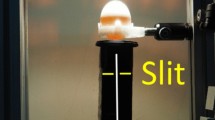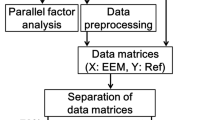Abstract
Designer hen shell eggs, with enhanced or reduced specific components, are used as part of a healthy diet, and such designer eggs must meet certain standards. A fast, nondestructive technology is required in order to ensure that these standards are met. In this study, we investigated the nondestructive estimation of intravitelline vitamin E and cholesterol concentrations in hen shell eggs using visible and near-infrared (VIS/NIR) spectroscopy. The values estimated using partial least-squares regression (PLSR) models were highly correlated with vitamin E concentration measurements by high-performance liquid chromatography and cholesterol concentration measurements by enzymatic analysis. Wavelength selection with the Martens uncertainty test successfully removed unimportant variables and enhanced the models' accuracy and reliability. However, spectral measurements of separated egg yolks with artificially controlled vitamin E and cholesterol concentrations did not afford accurate predictive models. This result for separated yolks, together with band assignments of PLSR models for hen shell eggs, suggested that VIS/NIR spectroscopy can indirectly estimate vitamin E and cholesterol concentrations in hen shell eggs by using information about other components.
Graphic abstract








Similar content being viewed by others
References
S. Ishikawa, Proteomic analysis of hen egg for improvement of food quality and functionality of egg products. Nippon Shokuhin Kagaku Kogaku Kaishi 59, 231–235 (2012). https://doi.org/10.3136/nskkk.59.231
K. Imaizumi, New developments in health and nutritional function promoted by chicken eggs. Nippon Shokuhin Kagaku Kogaku Kaishi 58, 341–345 (2011). https://doi.org/10.3136/nskkk.58.341
M. Rossi, Y. Nys, M. Anton, M. Bain, B. De Ketelaere, K. De Reu, I. Dunn, J. Gautron, M. Hammershøj, A. Hidalgo, A. Meluzzi, K. Mertens, F. Nau, F. Sirri, Developments in understanding and assessment of egg and egg product quality over the last century. Worlds Poult. Sci. J. 69, 414–429 (2013). https://doi.org/10.1017/S0043933913000408
S.M. Michella, B.T. Slaugh, Producing and marketing a specialty egg. Poult. Sci. 79, 975–976 (2000). https://doi.org/10.1093/ps/79.7.975
P.F. Surai, N.H.C. Sparks, Designer eggs: from improvement of egg composition to functional food. Trends Food Sci. Technol. 12, 7–16 (2001). https://doi.org/10.1016/S0924-2244(01)00048-6
A.T. Diplock, Antioxidant nutrients and disease prevention: an overview. Am. J. Clin. Nutr. 53, 189Sb–193S (1991). https://doi.org/10.1093/ajcn/53.1.189Sb
S. Leeson, Vitamin requirements: is there basis for re-evaluating dietary specifications? Worlds Poult. Sci. J. 63, 255–266 (2007). https://doi.org/10.1017/S0043933907001444
MEXT, Standard tables of food composition in Japan. (Seventh Revised Version) (2015).
D.J. McNamara, Eggs and heart disease risk: perpetuating the misperception. Am. J. Clin. Nutr. 75, 333–335 (2002). https://doi.org/10.1093/ajcn/75.2.333
K.L. Herron, M.L. Fernandez, Are the current dietary guidelines regarding egg consumption appropriate? J. Nutr. 134, 187–190 (2004). https://doi.org/10.1093/jn/134.1.187
M.L. Fernandez, Dietary cholesterol provided by eggs and plasma lipoproteins in healthy populations. Curr. Opin. Clin. Nutr. Metab. Care 9, 8–12 (2006). https://doi.org/10.1097/01.mco.0000171152.51034.bf
J.Y. Shin, P. Xun, Y. Nakamura, K. He, Egg consumption in relation to risk of cardiovascular disease and diabetes: a systematic review and meta-analysis. Am. J. Clin. Nutr. 98, 146–159 (2013). https://doi.org/10.3945/ajcn.112.051318
M.B. Katan, A.C. Beynen, Characteristics of human hypo- and hyperresponders to dietary cholesterol. Am. J. Epidemiol. 125, 387–399 (1987). https://doi.org/10.1093/oxfordjournals.aje.a114545
K.L. Herron, S. Vega-Lopez, K. Conde, T. Ramjiganesh, N.S. Shachter, M.L. Fernandez, Men classified as hypo- or hyperresponders to dietary cholesterol feeding exhibit differences in lipoprotein metabolism. J. Nutr. 133, 1036–1042 (2003). https://doi.org/10.1093/jn/133.4.1036
K.L. Herron, S. Vega-Lopez, K. Conde, T. Ramjiganesh, S. Roy, N.S. Shachter, M.L. Fernandez, Pre-menopausal women, classified as hypo- or hyper-responders, do not alter their LDL/HDL ratio following a high dietary cholesterol challenge. J. Am. Coll. Nutr. 21, 250–258 (2002). https://doi.org/10.1080/07315724.2002.10719218
A.C. Beynen, M.B. Katan, L.F. Van Zutphen, Hypo- and hyperresponders: individual differences in the response of serum cholesterol concentration to changes in diet. Adv. Lipid Res. 22, 115–171 (1987). https://doi.org/10.1016/B978-0-12-024922-0.50008-4
S. Grobas, J. Méndez, B.C. Lopez Bote, B.C. De Blas, G.G. Mateos, Effect of vitamin E and A supplementation on egg yolk alpha-tocopherol concentration. Poult. Sci. 81, 376–381 (2002). https://doi.org/10.1093/ps/81.3.376
H. Kamisoyama, K. Honda, K. Kitaguchi, S. Hasegawa, Transfer of dietary coenzyme Q10 into the egg yolk of laying hens. J. Poult. Sci. 47, 28–33 (2010). https://doi.org/10.2141/jpsa.009037
N. Abdel-Nour, M. Ngadi, S. Prasher, Y. Karimi, Prediction of egg freshness and albumen quality using visible/near infrared spectroscopy. Food Bioproc. Tech. 4, 731–736 (2011). https://doi.org/10.1007/s11947-009-0265-0
A. Giunchi, A. Berardinelli, L. Ragni, A. Fabbri, F.A. Silaghi, Non-destructive freshness assessment of shell eggs using FT-NIR spectroscopy. J. Food Eng. 89, 142–148 (2008). https://doi.org/10.1016/j.jfoodeng.2008.04.013
B.J. Kemps, F.R. Bamelis, B. De Ketelaere, K. Mertens, K. Tona, E.M. Decuypere, J.G. De Baerdemaeker, Visible transmission spectroscopy for the assessment of egg freshness. J. Sci. Food Agric. 86, 1399–1406 (2006). https://doi.org/10.1002/jsfa.2528
H. Lin, J. Zhao, L. Sun, Q. Chen, F. Zhou, Freshness measurement of eggs using near infrared (NIR) spectroscopy and multivariate data analysis. Innov. Food Sci. Emerg. Technol. 12, 182–186 (2011). https://doi.org/10.1016/j.ifset.2011.01.008
Y. Liu, Y. Ying, A. Ouyang, Y. Li, Measurement of internal quality in chicken eggs using visible transmittance spectroscopy technology. Food Control 18, 18–22 (2007). https://doi.org/10.1016/j.foodcont.2005.07.011
J. Zhao, H. Lin, Q. Chen, X. Huang, Z. Sun, F. Zhou, Identification of egg’s freshness using NIR and support vector data description. J. Food Eng. 98, 408–414 (2010). https://doi.org/10.1016/j.jfoodeng.2010.01.018
Y. Usui, K. Nakano, J. Mizutani, Studies on nondestructive detection of abnormal eggs (part 2)—the detection of blood spots in white-shelled eggs using visible spectroscopy. Nogyo Shisetsu 36, 11–16 (2005). https://doi.org/10.11449/sasj1971.36.11
Y. Usui, K. Nakano, M. Saitou, Studies on nondestructive detection of abnormal eggs (part 3)—the detection of blood spots in brown-shelled eggs using visible spectroscopy. Nogyo Shisetsu 36, 209–214 (2006). https://doi.org/10.11449/sasj1971.36.209
K. Nakano, J. Mizutani, Y. Ohtsuka, Studies on nondestructive detection of abnormal eggs (part 1)—detection of blood spots in eggs using image processing. Nogyo Shisetsu 29, 117–123 (1998). https://doi.org/10.11449/sasj1971.29.117
B. De Ketelaere, F. Bamelis, B. Kemps, E. Decuypere, J. De Baerdemaeker, Non-destructive measurements of the egg quality. Worlds Poult. Sci. J. 60, 289–302 (2004). https://doi.org/10.1079/WPS200417
Q. Zhao, X. Lv, Y. Jia, Y. Chen, G. Xu, L. Qu, Rapid determination of the fat, moisture, and protein contents in homogenized chicken eggs based on near-infrared reflectance spectroscopy. Poult. Sci. 97, 2239–2245 (2018). https://doi.org/10.3382/ps/pey070
R.L. Wehling, M.M. Pierce, G.W. Froning, Determination of moisture, fat and protein in spray-dried whole egg by near infrared reflectance spectroscopy. J. Food Sci. 53, 1355–1359 (1988). https://doi.org/10.1111/j.1365-2621.1988.tb09276.x
A. Lucas, D. Andueza, E. Rock, B. Martin, Prediction of dry matter, fat, pH, vitamins, minerals, carotenoids, total antioxidant capacity, and color in fresh and freeze-dried cheeses by visible-near-infrared reflectance spectroscopy. J. Agric. Food Chem. 56, 6801–6808 (2008). https://doi.org/10.1021/jf800615a
I. González-Martín, J.M. Bustamante-Rangel, M.M. Delgado-Zamarreño, Near infrared spectroscopy (NIRS) reflectance technology for determination of tocopherols in animal feeds. Anal. Chim. Acta 558, 132–136 (2006). https://doi.org/10.1016/j.aca.2005.10.085
I. González-Martín, J.M. Hernández-Hierro, M. Bustamante-Rangel, N. Barros-Ferreiro, Near-infrared spectroscopy (NIRS) reflectance technology for the determination of tocopherols in alfalfa. Anal. Bioanal. Chem. 386, 1553–1558 (2006). https://doi.org/10.1007/s00216-006-0666-0
S. Kuroki, T. Kanoo, H. Itoh, Y. Ohkawa, H. Kamisoyama, Nondestructive measurement of yolk viscosity in lightly heated chicken shell eggs. J. Food Eng. 205, 18–24 (2017). https://doi.org/10.1016/j.jfoodeng.2017.02.030
A. Hanslmeier, Water in the Universe. Astrophysics and Space Science Library (Springer Netherlands, 2010), pp. 242.
S. Šašić, Y. Ozaki, Short-wave near-infrared spectroscopy of biological fluids. 1. Quantitative analysis of fat, protein, and lactose in raw milk by partial least-squares regression and band assignment. Anal. Chem. 73, 64–71 (2001). https://doi.org/10.1021/ac000469c
M. Taniguchi, J.S. Lindsey, Database of absorption and fluorescence spectra of %3e 300 common compounds for use in PhotochemCAD. Photochem. Photobiol. 94, 290–327 (2018). https://doi.org/10.1111/php.12860
K. Mertens, I. Vaesen, J. Loffel, B. Kemps, B. Kamers, C. Perianu, J. Zoons, P. Darius, E. Decuypere, J. De Baerdemaeker, B. De Ketelaere, The transmission color value: A novel egg quality measure for recording shell color used for monitoring the stress and health status of a brown layer flock. Poult. Sci. 89, 609–617 (2010). https://doi.org/10.3382/ps.2009-00261
B.G. Osborne, T. Fearn, Near Infrared Spectroscopy in Food Analysis (Wiley, Longman Scientific & Technical, 1986)
H. Abe, Estimation of heat capacity and properties of water by spectrum decomposition of the second overtone band of OH stretching vibration. J. Near Infrared Spectrosc. 12, 45–54 (2004). https://doi.org/10.1255/jnirs.409
I.V. Kovalenko, G.R. Rippke, C.R. Hurburgh, Determination of amino acid composition of soybeans (Glycine max) by near-infrared spectroscopy. J. Agric. Food Chem. 54, 3485–3491 (2006). https://doi.org/10.1021/jf052570u
M.W. Davey, W. Saeys, E. Hof, H. Ramon, R.L. Swennen, J. Keulemans, Application of visible and near-infrared reflectance spectroscopy (Vis/NIRS) to determine carotenoid contents in banana (Musa spp.) fruit pulp. J. Agric. Food Chem. 57, 1742–1751 (2009). https://doi.org/10.1021/Jf803137d
B.J. Kemps, B. De Ketelaere, F.R. Bamelis, K. Mertens, E.M. Decuypere, J.G. De Baerdemaeker, F. Schwägele, Albumen freshness assessment by combining visible near-infrared transmission and low-resolution proton nuclear magnetic resonance spectroscopy. Poult. Sci. 86, 752–759 (2007). https://doi.org/10.1093/ps/86.4.752
S.E. Scheideler, P. Weber, D. Monsalve, Supplemental vitamin E and selenium effects on egg production, egg quality, and egg deposition of α-tocopherol and selenium. J. Appl. Poult. Res. 19, 354–360 (2010). https://doi.org/10.3382/japr.2010-00198
H. Abe, Y. Yalabe, M. Amari, Non-destructive determination of egg-cholesterol by near infrared (NIR) spectroscopy. Nihon Chikusan Gakkaiho 84, 77–80 (2013). https://doi.org/10.2508/chikusan.84.77
H. Abe, M. Amari. Method for measuring cholesterol contained in chicken egg using non-destructive means. US9372179B2 Jun. 21, 2016 (2016).
D.J. Crockford, E. Holmes, J.C. Lindon, R.S. Plumb, S. Zirah, S.J. Bruce, P. Rainville, C.L. Stumpf, J.K. Nicholson, Statistical heterospectroscopy, an approach to the integrated analysis of NMR and UPLC-MS data sets: application in metabonomic toxicology studies. Anal. Chem. 78, 363–371 (2006). https://doi.org/10.1021/ac051444m
Y. Uwadaira, Y. Sekiyama, A. Ikehata, An examination of the principle of non-destructive flesh firmness measurement of peach fruit by using VIS–NIR spectroscopy. Heliyon 4, e00531 (2018). https://doi.org/10.1016/j.heliyon.2018.e00531
G. Martino, M.N. Haouet, S. Marchetti, L. Grotta, V. Ponzielli, Effect of vitamin E supplementation on egg yolk quality and oxidative stability. Asian J. Agric. Food Sci. 20, 248–255 (2014)
R.G. Elkin, Reducing shell egg cholesterol content. I. Overview, genetic approaches, and nutritional strategies. Worlds Poult. Sci. J. 62, 665–687 (2006). https://doi.org/10.1017/S0043933906001206
R.G. Elkin, Reducing shell egg cholesterol content. II. Review of approaches utilizing non-nutritive dietary factors or pharmacological agents and an examination of emerging strategies. Worlds Poult. Sci. J. 63, 5–32 (2007). https://doi.org/10.1017/S0043933907001249
H.D. Griffin, Manipulation of egg-yolk cholesterol-a physiologists view. Worlds Poult. Sci. J. 48, 101–112 (1992). https://doi.org/10.1079/Wps19920010
S. Abdanan Mehdizadeh, S. Minaei, N.H. Hancock, M.A. Karimi Torshizi, An intelligent system for egg quality classification based on visible-infrared transmittance spectroscopy. Inf. Process. Agric. 1, 105–114 (2014). https://doi.org/10.1016/j.inpa.2014.10.002
Y. Kita, K. Kato, H. Kim, S. Hujitani, A. Kashimori, Nondestructive measurement of shell egg freshness using transmission spectroscopy—freshness prediction fulfilling all storage conditions: sealing, opening and in carbon dioxide. Jpn. J. Food Eng. 8, 83–88 (2007). https://doi.org/10.11301/jsfe2000.8.83
J. Workman, L. Weyer, Practical Guide and Spectral Atlas for Interpretive Near-Infrared Spectroscopy (CRC Press, Boca Raton, 2012)
Y. Ozaki, Near-infrared spectroscopy. Spectroscopy Series (Kodansha, Tokyo, 2015)
Acknowledgements
We thank Shiho Yamanaka and Yuriko Pak, who were our former students, for their assiduous acquisition of data. We also express our appreciation to Akio Nakazato and others of Kagotani Co. Ltd. for their generous provision of samples. Our deep-felt thanks to the laboratory members for their being willing to try anything while we figured out how to write up this work.
Funding
A part of this work was supported financially by Hyogo Agri-innovation Research and Development Support Project in 2014.
Author information
Authors and Affiliations
Corresponding author
Ethics declarations
Conflict of interest
The authors declare that they have no conflict of interest.
Additional information
Publisher's Note
Springer Nature remains neutral with regard to jurisdictional claims in published maps and institutional affiliations.
Device and measurement method for quality attributes of shell egg is patented (JP 6518171).
Rights and permissions
About this article
Cite this article
Kuroki, S., Kanoo, T., Itoh, H. et al. Nondestructive VIS/NIR spectroscopy estimation of intravitelline vitamin E and cholesterol concentration in hen shell eggs. Food Measure 14, 1116–1124 (2020). https://doi.org/10.1007/s11694-019-00361-8
Received:
Accepted:
Published:
Issue Date:
DOI: https://doi.org/10.1007/s11694-019-00361-8




